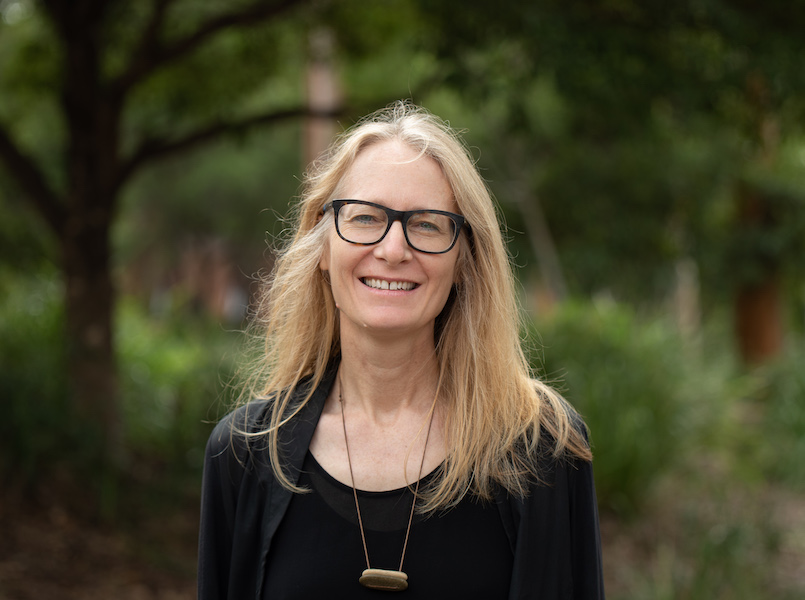Researcher Highlights
Creative practice research sparks new possibilities
Pia Ednie-Brown
An architectural theorist, researcher and creative practitioner, Professor Pia Ednie-Brown’s provocative work encourages people to reconsider how they interact with their built and social environments.

Professor Pia Ednie-Brown is a passionate educator and an avid creative practice researcher, with designed works forming both part of her research methods and output.
Pia has led or been an investigator on four large projects that use creative practice research as a mode of investigation in the last 16 years, totalling more than $2.8 million in research funding. Her projects have explored topics such as new forms of collaborative creative practice knowledge production, the role of ethics in creative practice and differentiating creative practice research models.
Pia’s work is held in high esteem nationally and internationally. She has presented at renowned venues such as the Guggenheim New York City, the National Gallery of Victoria and TEDX, to name a few. Her research insights are also available in print, with numerous papers, book chapters and two books: Plastic Green: designing for environmental transformation (RMIT Press, 2009), and The Innovation Imperative: Architectures of Vitality (AD, Wiley, 2013).
Reconsidering our place in the world
Pia is the director of Onomatopoeia, a creative research practice dedicated to combatting anthropocentrism—the assumption that human beings are the centre of the world—within architecture and beyond.
Onomatopoeia provides a platform for Pia to test and drive her creative research projects, from a small building renovation, to inhabitable installations, small sculptural objects and writing projects.
Pia is particularly proud of her research project Avery Green, a house extension in Melbourne. She explains that the renovation and extension were approached as a process of getting to know Avery as a 'person', drawing on her character and allowing it to transform.
“This project was undertaken to raise questions about how we might productively reassess our relationships with sites, buildings and creative work through the concept of personhood,” explains Pia.
“While I had already gathered a sense of her disposition while living with Avery for six years, ushering her through a significant architectural transformation allowed me to know her in new ways, experiencing emerging qualities that I guided her toward in my role as designer.”
Avery Green was the subject of Pia’s TEDX talk. The unique project was reviewed in Architecture Australia and showcased at the RMIT Design Hub in 2018. For Pia, the project was a valuable catalyst for exploring people’s relationships with their surroundings.
“My hope is that fostering a sense of personal relationship with the buildings we inhabit will also encourage deeper awareness, care and respect for our environments more broadly.”
The space to learn and create
Pia has coordinated, developed and taught undergraduate and postgraduate curriculum for almost two decades, and has received several awards for her innovative pedagogy. Her design teaching studios are always research-led and aim to address real-world concerns through multi-disciplinary collaboration.
“My studios encourage risk-taking and play in the belief that students need supportive environments in which to take chances, move beyond their comfort zone and explore new ideas.
“For example, one of my studios aimed to reimagine a primary school in Thornbury, Victoria. The project involved engaging with the primary school students, encouraging them to draw pictures of their ideal school, grow bean seeds, and bring them in to become part of a school bean garden.
“In tandem with information gleaned through this engagement with the children,
architecture students explored the educational ideas of the Reggio Emilia Approach, and used
this to generate design ideas for a school that engaged with its wider community in new ways.”
During her 20-year tenure with RMIT, Pia set up a cross-disciplinary postgraduate course for a new Spatial Information Architecture Laboratory (SIAL) to be directed by Professor Mark Burry. In the first year of the course, Pia worked with a group of students to produce a major installation in the State Library of Victoria: Skins of Intimate Distance.
“This project both enabled individual interactive works and operated as a collective endeavour.”
One of those collective endeavours was a haptic feedback system for the multi-user interactive artwork, Intimate Transactions, conducted in collaboration with Keith Armstrong and the Transmute Collective.
“Intimate Transactions was ground-breaking in a media art and design context for the nature of its interface. It has been recognised internationally for its excellence and innovation, having been shown internationally in over 20 locations around the world, has a book dedicated to
it, and was awarded Honorary Mention in the 2005 Prix Ars Electronica.”
Intimate Transactions was produced in collaboration with Pia’s first research candidate supervision, which led to a co-published paper in 2006. Since then, Pia has supervised more than 19 creative practice PhD candidates through to completion.
A strong career trajectory
Pia’s highly successful teaching and research career has been repeatedly acknowledged by esteemed awards, from the 2000 BHERT Award, 10th Annual Business and Higher Education Round Table for “Outstanding Achievement in Collaboration in Education and Training” for her collaborative work as part of the “Telstra Home Team” during her doctorate years, to a RMIT University Research Supervision Excellence ECR Award in 2013, and the RMIT Graduate Research Leadership Award in 2017.
“It’s exciting to be part of the development and maturing recognition of design and creative practice research. Witnessing this maturation close at hand has acted to deeply shape my own career emphases and trajectory.”
The University of Newcastle acknowledges the traditional custodians of the lands within our footprint areas: Awabakal, Darkinjung, Biripai, Worimi, Wonnarua, and Eora Nations. We also pay respect to the wisdom of our Elders past and present.
